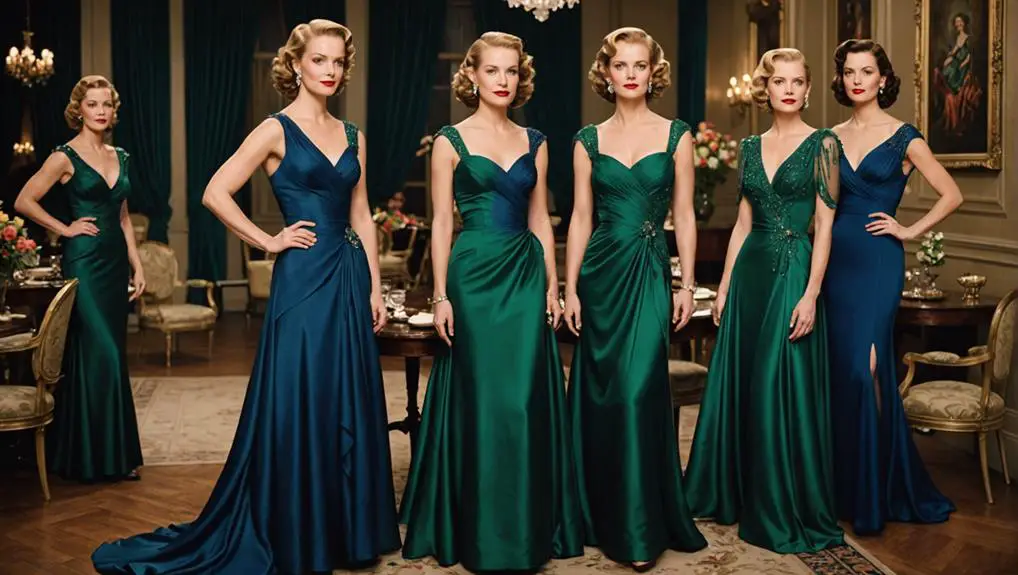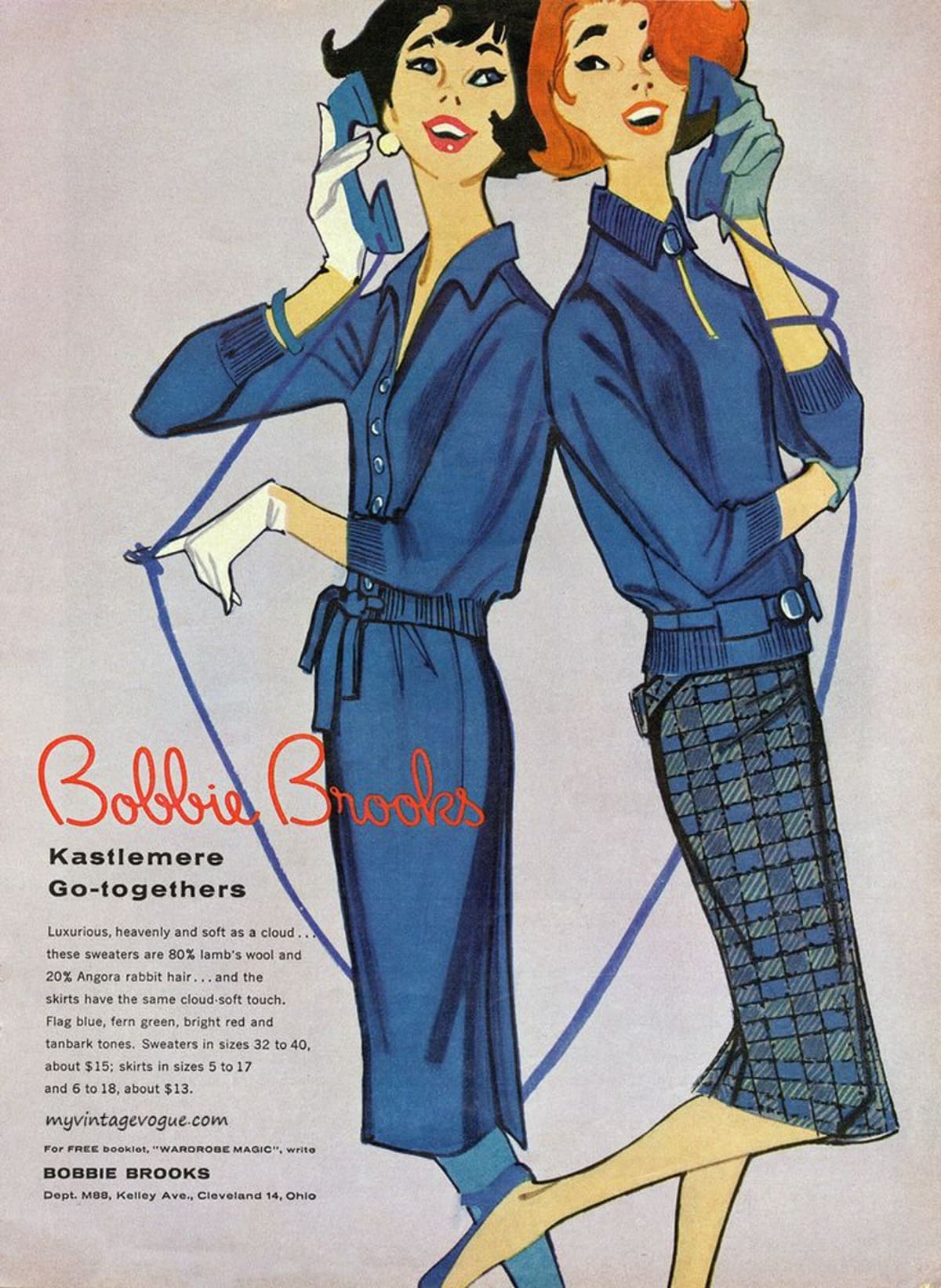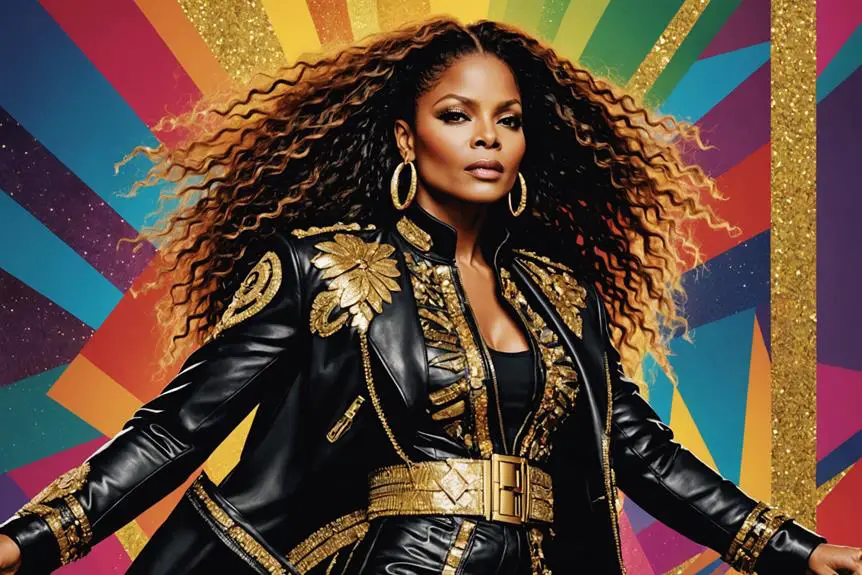In the 1940s, women's silk evening gowns embodied both elegance and resilience during a challenging time. Designers like Christian Dior and Mainbocher introduced structured silhouettes with defined waistlines, emphasizing femininity. You'd find luxurious fabrics like silk, satin, and taffeta, often adorned with sequins or lace, in striking jewel tones. These gowns marked a cultural shift, as women sought beauty post-war, while Hollywood glamorized such styles, inspiring public taste. Accessories like long gloves and rhinestone chokers completed the look. As you explore further, you'll discover how these gowns shaped both fashion and society's evolving identity in that era.
Overview of 1940s Evening Gowns
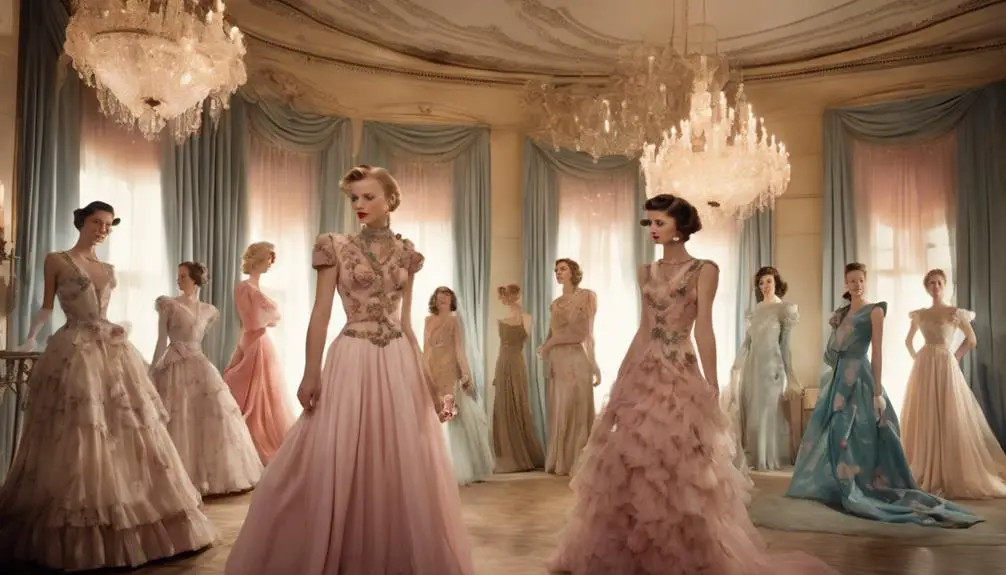
In the 1940s, evening gowns emerged as symbols of elegance and sophistication, reflecting the era's unique challenges and triumphs. The fabric choice often leaned toward luxurious silk, satin, and taffeta, a nod to the resource constraints imposed by wartime. These vintage evening gowns showcased structured silhouettes, with defined waistlines that emphasized femininity and glamour. Popular styles included both tea-length and floor-length designs, allowing you to select an option that suited the occasion. This period also saw the rise of vintage clothing labels, which played a vital role in defining the authenticity and quality of these garments.
Key design elements featured embellishments like beaded sequins and delicate lace, enhancing the gowns' visual appeal. The variety in sleeve lengths and necklines—ranging from sweetheart to off-the-shoulder—allowed for personal expression and versatility in styling. The color palette, shifting from deep hues to soft pastels, mirrored a post-war optimism and signified social status through fashion choices.
As you explore 1940s evening gowns, you'll notice how they seamlessly blended classic styles with innovative techniques. Even the cocktail dress of the time embraced these attributes, making it a staple in women's formal wear. The evening gowns of this era truly encapsulated a moment of resilience and beauty, forever influencing fashion.
Key Designers and Influences
The evolution of women's silk evening gowns in the 1940s was considerably shaped by several key designers who redefined fashion during this transformative period. Mainbocher, with his elegant and timeless designs, played a pivotal role in popularizing silk evening gowns that mirrored the post-war craving for luxury and femininity. His creations often featured sumptuous fabrics like black silk charmeuse, enhancing the allure of evening dresses.
Christian Dior's revolutionary "New Look," introduced in 1947, brought a cinched waist and full skirt that became emblematic of the era. This silhouette influenced countless designers and women alike, making silk evening gowns a staple for elegance. Givenchy gained fame for dressing icons such as Audrey Hepburn, crafting sophisticated silk evening gowns that exuded grace and charm.
Meanwhile, Norman Norell rose to prominence, celebrated for his luxurious evening wear, which frequently incorporated intricate detailing and silk fabrics. The innovative structures of Balenciaga also left a lasting impact, pushing the boundaries of traditional gown design. Together, these designers not only shaped the vintage 1940s aesthetic but also set the stage for future fashion trends in evening wear.
Popular Styles and Silhouettes
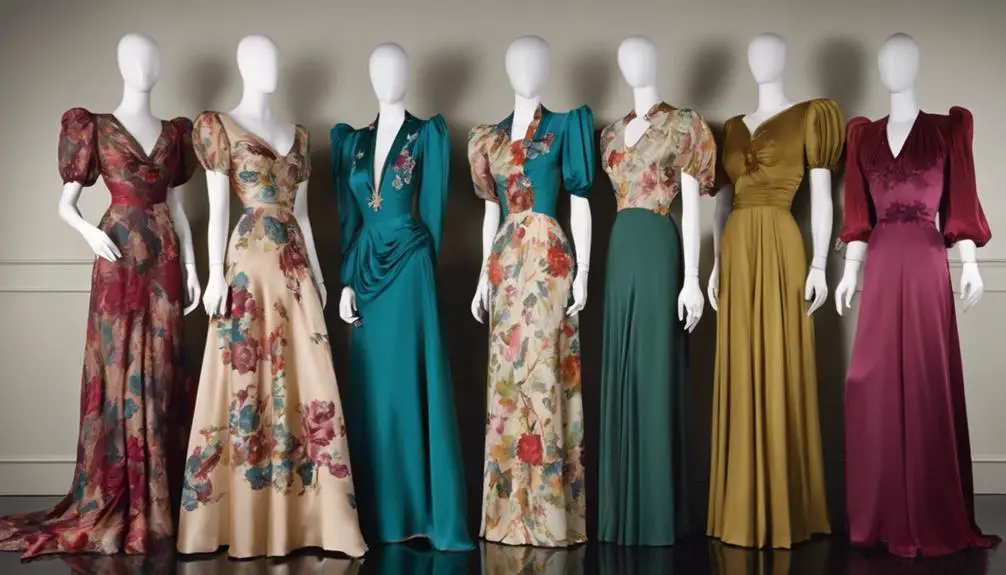
Silk evening gowns from the 1940s showcase a fascinating blend of structure and elegance, embodying the era's desire for femininity and sophistication. These gowns often featured structured silhouettes with defined waistlines, accentuating the coveted hourglass figure. This silhouette was not just a trend; it represented a return to traditional femininity after the hardships of war.
You'd find a variety of styles, including tea-length and floor-length designs, both characterized by elegant draping techniques that introduced movement and fluidity. Necklines varied widely—from sweetheart to off-the-shoulder—while sleeve options ranged from cap styles to long, flowing designs, enhancing the gown's overall feminine elegance.
The introduction of Christian Dior's "New Look" in 1947 further revolutionized evening wear by promoting full skirts, which celebrated a more opulent aesthetic. Luxurious materials like silk, satin, and taffeta dominated the scene, often enhanced with embellishments such as sequins and lace, adding layers of sophistication. By embracing these popular styles and silhouettes, the 1940s cemented silk evening gowns as timeless representations of glamour and grace, perfectly reflecting the spirit of the era.
Fabrics and Color Palettes
1940s evening gowns thrived on the luxurious textures and rich colors that defined the decade's fashion landscape. You'd notice that the predominant fabrics were silk, satin, and taffeta, each contributing to the sophisticated appearance and graceful drape of these gowns. Initially, pastel shades like light blue and rose pink dominated, but as the decade progressed, deeper jewel tones emerged, reflecting a post-war optimism that encouraged a celebration of color.
Floral prints adorned many gowns, adding a touch of femininity and vibrancy. Designers often combined sheer fabrics like chiffon and organza for lighter creations, while heavier materials were favored for structured silhouettes that enhanced the gown's overall elegance. Innovative draping techniques played a vital role in this era, allowing for movement and fluidity that captivated the eye.
Gowns in rich colors such as crimson and emerald became increasingly popular, transforming evening wear into a statement of glamour and exuberance. This shift in fabrics and color palettes not only captured the essence of the time but also showcased the evolution of women's fashion, highlighting their resilience and desire for beauty amidst changing societal landscapes.
Accessories and Complementary Items
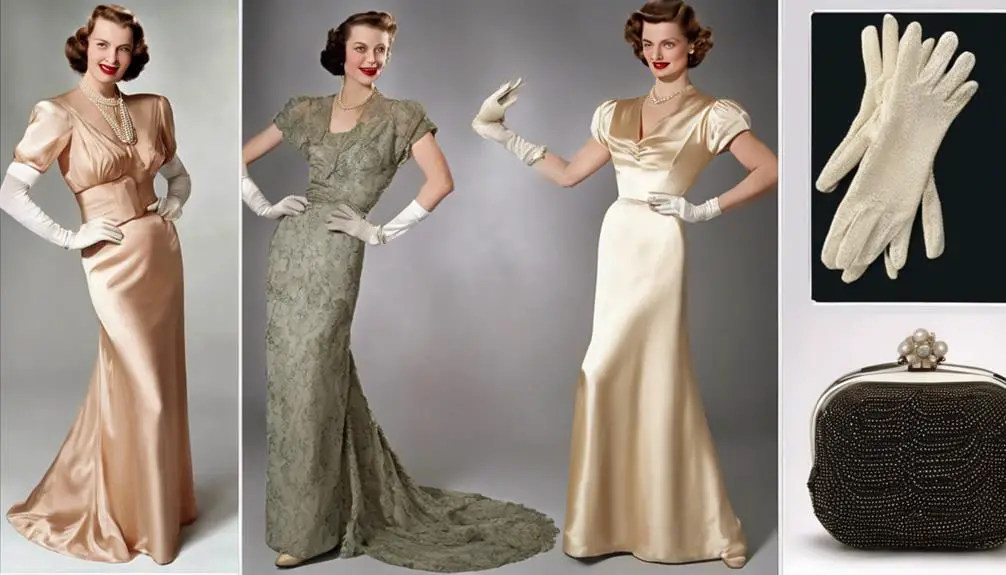
Completing the ensemble of a silk evening gown required careful attention to accessories that not only complemented the outfit but also elevated it to new heights of sophistication. In the 1940s, rhinestone chokers and pearl accessories were essential, adding a touch of glamour to your vintage dresses. Large bracelets and dramatic jewelry, including oversized rings and gold necklaces, drew the eye and enhanced the elegance of your appearance.
Long ruched gloves that extended to the elbow were another hallmark of sophistication, seamlessly blending with the silk evening gown. Small evening purses crafted from satin or rayon typically matched the gown's color and style, serving as both a practical item and a stylish accessory.
Hair accessories like flower clips and rhinestone combs transformed hairstyles, complementing looks such as braided crowns or elegant updos. These details contributed considerably to the polished aesthetic that defined 1940s evening wear. Together, these accessories not only adorned the silk evening gown but also expressed individuality and taste, ensuring you stood out at any formal occasion.
Pricing Trends and Value
When it comes to pricing trends for evening gowns, the vintage market reveals fascinating insights into both value and desirability. The average price for a 1940s silk evening gown hovers around $945, with variations from $227 to a staggering $18,025. Black silk dresses, in particular, stand out, often commanding premium prices due to their classic appeal and timeless style.
Notable designers like Christian Dior and Norman Norell have left a significant mark on pricing trends, as their creations fetch top dollar at auctions and vintage shops. The allure of silk vintage gowns, especially those with unique design features, makes them highly sought after by collectors. Factors such as condition and brand reputation play critical roles in determining value; well-preserved pieces tend to attract higher bids.
In today's market, the demand for vintage-inspired clothing has also impacted pricing. New designs reminiscent of the 1940s typically range from $46.72 to $299.00, showcasing a growing appreciation for this era's elegance. Understanding these dynamics helps you navigate the fascinating world of vintage evening gowns, ensuring you appreciate both their historical significance and current value.
Cultural Impact and Legacy
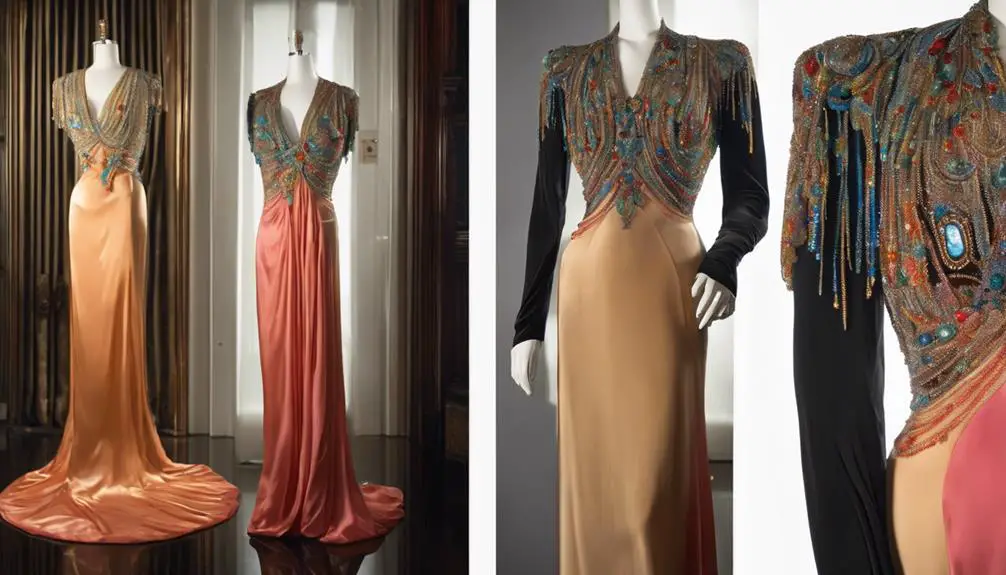
The legacy of women's silk evening gowns from the 1940s extends far beyond their alluring designs and luxurious fabrics; they encapsulated a profound cultural shift in post-war society. As women moved away from the practical attire of wartime, these gowns symbolized newfound optimism and femininity. Hollywood stars showcased glamorous styles in films, shaping public perceptions of elegance and inspiring women everywhere.
The influence of fashion magazines cannot be overstated; they guided trends and offered inspiration, helping women emulate the styles of their favorite icons. Designers like Christian Dior revolutionized fashion with the "New Look," emphasizing feminine silhouettes that defined the decade and reshaped women's fashion for years to come.
Here's a comparison of key elements that illustrate the impact of silk evening gowns during this era:
| Element | Description |
|---|---|
| Cultural Shift | Change from practical to luxurious fashion choices |
| Influence of Stars | Hollywood icons popularized glamorous evening gowns |
| Fashion Magazines | Provided guidance and inspiration for women's styles |
| Social Status | Evening gowns became symbols of sophistication at events |
Thus, silk evening gowns of the 1940s remain an indication of a transformative era in fashion and society.
Frequently Asked Questions
What Fabrics Were Popular in the 1940s?
In the 1940s, you'd find silk, rayon, taffeta, and velvet dominating fabrics. Each offered unique qualities—silk's luxury, rayon's affordability, taffeta's crispness, and velvet's warmth—catering to varied tastes and evolving fashion trends during that era.
Which Girlie Fabrics Were Popular in Evening Wear the 1940's?
In the 1940s, you'd find taffeta, chiffon, and velvet dominating evening wear. These girlie fabrics provided elegance and structure, often showcasing bold colors and floral prints, reflecting the era's desire for sophistication amidst wartime constraints.
What Were Wedding Dresses Made of in the 1940s?
In the 1940s, wedding dresses were crafted from luxurious fabrics like silk, satin, and lace. You'd notice intricate embellishments, fitted bodices, and flowing skirts, all reflecting an era of elegance amidst wartime resourcefulness.
What Were 1940S Dresses Called?
In the 1940s, dresses worn for formal occasions were typically called evening gowns. These garments showcased elegance and sophistication, often with structured silhouettes and luxurious fabrics, reflecting the era's post-war optimism and evolving fashion trends.
